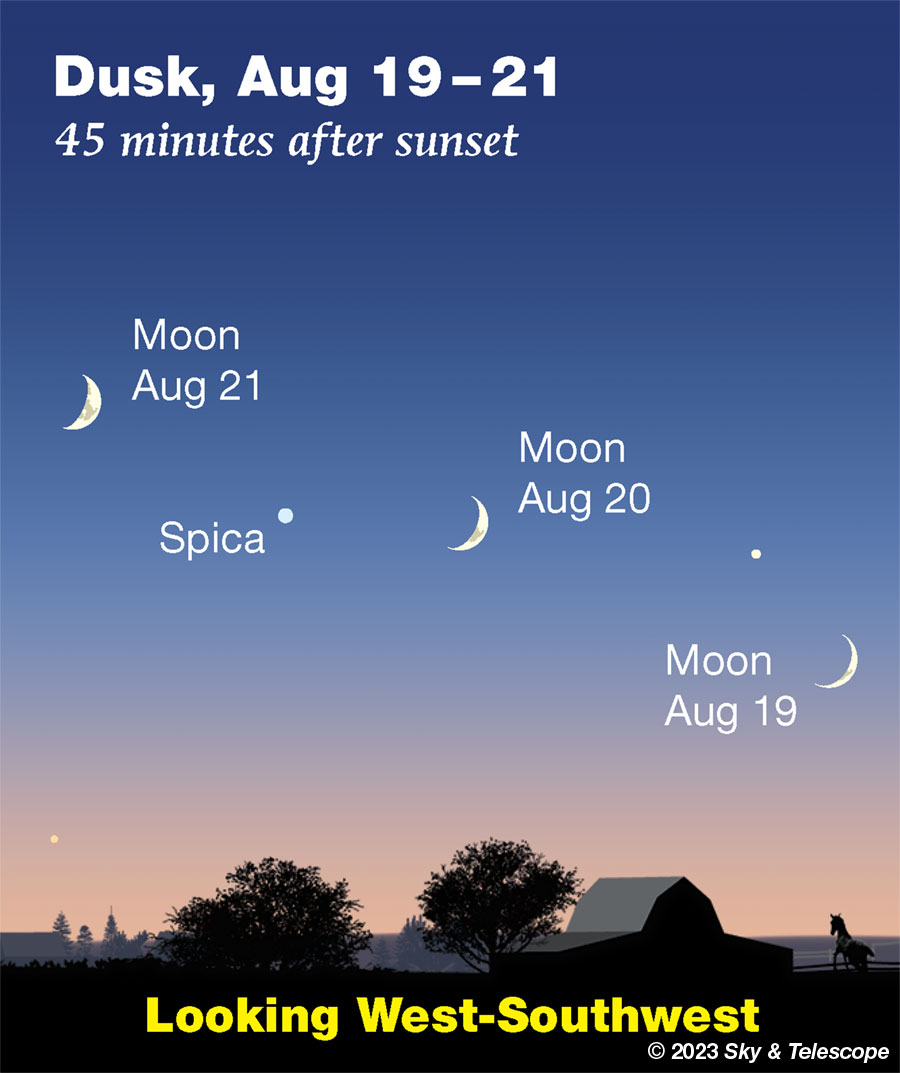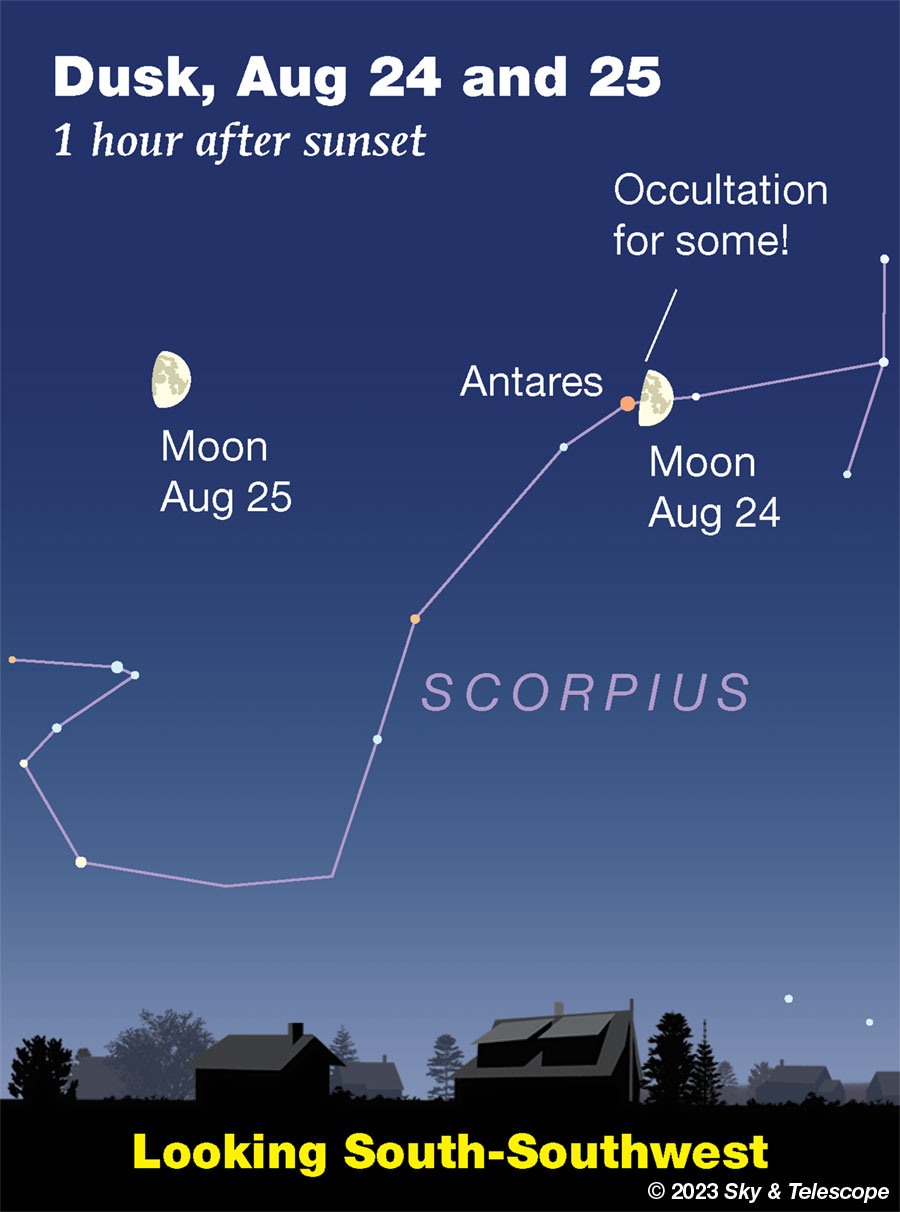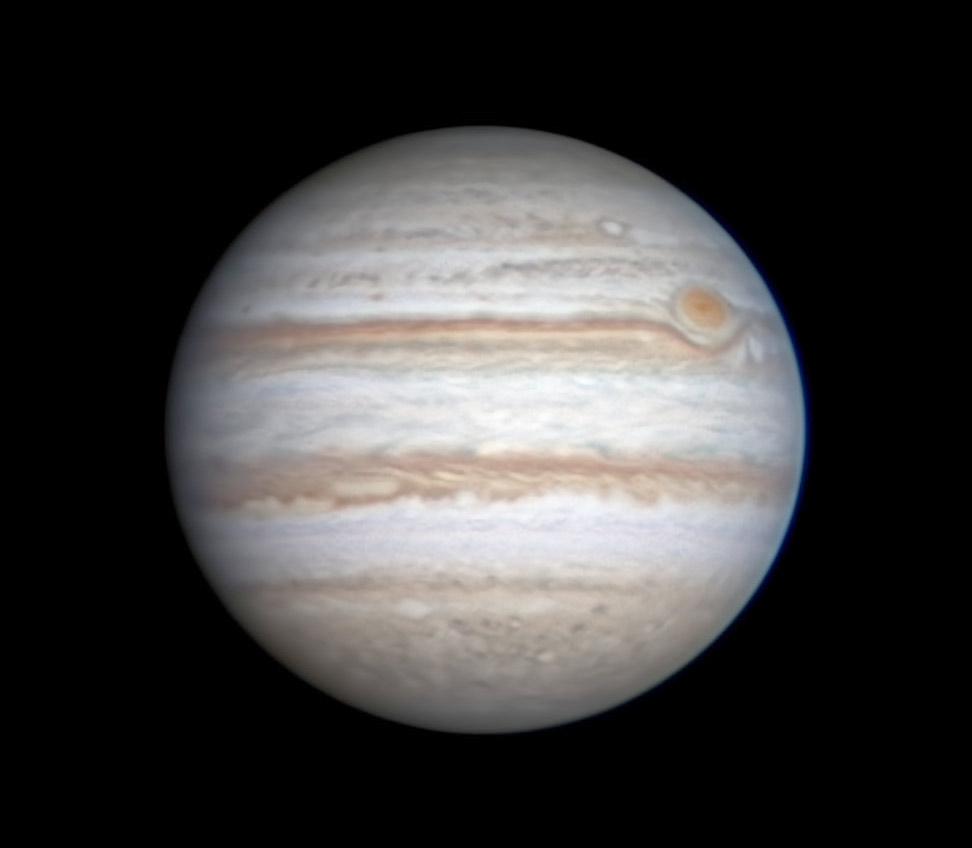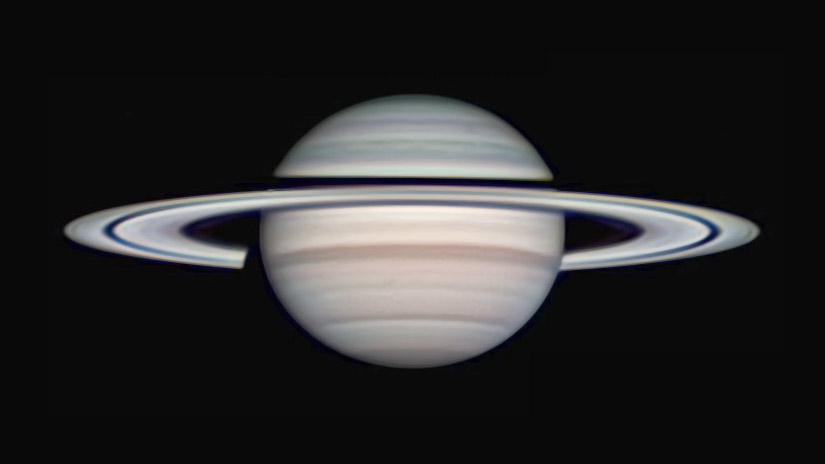FRIDAY, AUGUST 18
■ A twilight challenge. About 30 minutes after sunset, look for the thin crescent Moon very low due west. Binoculars or a telescope might show faint Mars (magnitude +1.8) just below or lower left of the Moon, by about 1° or 2° (for North America). Some 6° below them, Mercury is probably too low and faint to detect at all.
SATURDAY, AUGUST 19
■ Saturn climbs well up in the southeast by 10 or 11 p.m. Look below Saturn, by about two fists at arm's length, for Fomalhaut, the Autumn Star on its way up. No other 1st-magnitude star is anywhere near there to confuse them with.
SUNDAY, AUGUST 20
■ In the fading dusk, look for Spica left of the Moon as shown below. Spica is most often thought of as a springtime star. Now it's finally riding off into the sunset.

MONDAY, AUGUST 21
■ Different people have an easier or harder time seeing star colors, especially subtle ones. To me, the tints of bright stars stand out a little better in a sky that's the deep blue of late twilight.
For instance, the two brightest stars of summer are Vega, nearly overhead at that time, and Arcturus shining in the west. Vega is white with just a touch of blue. Arcturus is pale yellow-orange. Do their colors stand out a little better for you in late twilight? Could this be a color-contrast effect of seeing yellow, orange, or orange-red stars on a blue background?
Vega is a white-hot, type-A star 25 light-years away. Arcturus is a less hot, type-K giant 37 light-years distant.
TUESDAY, AUGUST 22
■ As August proceeds and nights begin to turn chilly, the Great Square of Pegasus looms up in the east, balancing on one corner. Its stars are only 2nd and 3rd magnitude, and your fist at arm's length fits inside it.
From the Square's left corner extends the main line of the constellation Andromeda: three stars (including the corner) running lower leftward. They're as bright as those forming the Square itself.
This whole giant pattern was named "the Andromegasus Dipper" by the late Sky & Telescope columnist George Lovi. It's shaped sort of like a giant Little Dipper with an extra-big bowl, and it's currently lifting its contents upward.
■ The actual Little Dipper, meanwhile, is over your left shoulder in the north. It's less than half as long as the Andromegasus Dipper, and most of it is much fainter. It's standing on its handle and tipping over leftward; the Little Dipper is rotated more than 90° counterclockwise compared to Andromegasus. It's currently dumping its contents out.
WEDNESDAY, AUGUST 23
■ First-quarter Moon this evening and tomorrow evening (exactly first-quarter at 5:57 a.m. EDT Thursday morning, which splits the difference between those two evenings for the Americas). This evening the Moon is low in the southwest after dark, to the right of Antares and the head of Scorpius.
THURSDAY, AUGUST 24
■ Moon occults Antares. Now the Moon shines near 1st-magnitude Antares as seen from the Americas , as shown below — and the Moon will occult Antares for much of the continental United States and southern Canada.
For the northeastern seaboard, the Moon will be very low over the southwest horizon at the time of Antares's disappearance behind its dark limb. In most of the West, the sky will still be bright or even full daylight. But everywhere in between, this will be the best lunar occultation of a star in quite a while!
The occultation is grazing for parts of north-central Florida, with Antares skimming the mountains and valleys along the Moon's southern limb.
See map and timetables. The first two timetables are very long. The first gives the time when Antares disappears behind the Moon's dark limb for many locations; the second table gives the time of its reappearance out from behind the Moon's bright limb (much harder to observe). Scroll to be sure you're using the correct table; watch for the new heading as you scroll down. The first two letters in each entry are the country abbreviation ("CA" is Canada, not California). The times are given in UT (GMT) August 25th. UT is 4 hours ahead of Eastern Daylight Time, 5 ahead of CDT, 6 ahead of MDT, and 7 ahead of PDT.
For instance: Use the tables to see that for Chicago, Antares will disappear at 9:29 p.m. CDT on the 24th when the Moon is 14° above the horizon. Antares reappears for Chicago at 10:33 p.m. CDT with the Moon only 7° up.

The latitude you're watching from also affects the Moon's apparent position. The farther north you are, the farther north you'll see the Moon against the background stars. One Moon diameter is roughly the north-south height of the continental United States.
In these scenes we always show the Moon about three times its actual apparent size, and we position it for an observer at 40° north latitude, 90° west longitude, near the population center of North America. So take the Moon's representation with Antares here as symbolic only; your circumstances will differ. (And never will a star appear in front of the Moon's dark portion!)
FRIDAY, AUGUST 25
■ How soon after sunset can you see the big Summer Triangle? Face east. Vega, the Triangle's brightest star, is nearly at the zenith (for skywatchers at mid-northern latitudes). Deneb is the first bright star to Vega's east-northeast. Altair shines less high in the southeast.
SATURDAY, AUGUST 26
■ Saturn is at opposition tonight (exactly so at 4 a.m. on the 27th EDT). In a telescope, do you notice that Saturn's rings are distinctly brighter, compared to Saturn's globe, than you usually see them? This is the Seeliger effect, caused by the solid ring particles backscattering sunlight to us when the Sun is almost directly behind us. The dusty surfaces of the Moon and Mars also display this "opposition effect," but Saturn's clouds do not. In the case of Saturn the effect is named for Hugo von Seeliger, who studied it in detail and published his findings in 1887.
The brightening begins several days before Saturn's opposition, is strongest right around that date, and fades for several days after.
SUNDAY, AUGUST 27
■ The waxing gibbous Moon shines in the south after dark. High above it, by three or four fists at arm's length, spot 1st-magnitude Altair with its little sidekick, 3rd-magnitude Tarazed (Gamma Aquilae) about a finger-width above it.
Much closer to the right of the Moon is the Sagittarius Teapot. Its four-star handle is the part closest to the Moon, less than a fist at arm's length. About a fist right of the handle, and perhaps a bit lower, is the Teapot's spout. Binoculars help through the moonlight.
This Week's Planet Roundup
Mercury and Mars finally disappear down into the sunset in the west.
Venus (about magnitude –4.3) emerges very low in brightening dawn this week. Look for it just above the horizon due east starting about 20 or 30 minutes before sunrise. Binoculars will help. Venus gets higher and less difficult every day.
Even low magnification will show that, as Venus emerges from inferior conjunction, it's again a very thin crescent. The crescent will get thicker and smaller in the weeks to come as it shines higher in the dawn, the reverse of how it grew thinner and larger while heading down into the sunset last month.
Jupiter (magnitude –2.5, in Aries) rises around 11 p.m. Watch for it to come up low in the east-northeast. By the beginning of dawn, Jupiter shines very high in the south.

Saturn (magnitude +0.5, in dim Aquarius) rises in bright twilight; it comes to opposition this week, on August 26th. In late twilight you'll find Saturn glowing as the brightest thing low in the east-southeast. It's at a fairly good height for telescopic observing by 11 p.m. (by which time Fomalhaut is twinkling two fists below it). Saturn is at its highest in the south around 1 a.m.
Watch for the Seeliger Effect to develop on Saturn's rings this week; see August 26th above.

Saturn is very close to opposition now, so the shadow of the globe on the rings behind (the black gap at the lower left here) has disappeared from view; Saturn's shadow is now directly behind it from Earth's point of view.
Uranus, magnitude 5.7 in Aries, is nice and high in late evening, about 8° east of Jupiter.
Neptune, magnitude 7.8 at the Aquarius-Pisces border, is high by midnight, about 2o° east of Saturn.
All descriptions that relate to your horizon — including the words up, down, right, and left — are written for the world's mid-northern latitudes. Descriptions and graphics that also depend on longitude (mainly Moon positions) are for North America.
Eastern Daylight Time (EDT) is Universal Time minus 4 hours. UT is sometimes called UTC, GMT, or Z time.
Want to become a better astronomer? Learn your way around the constellations. They're the key to locating everything fainter and deeper to hunt with binoculars or a telescope.
This is an outdoor nature hobby. For a more detailed constellation guide covering the whole evening sky, use the big monthly map in the center of each issue of Sky & Telescope, the essential magazine of astronomy.
Once you get a telescope, to put it to good use you'll need a much more detailed, large-scale sky atlas (set of charts). The basic standard is the Pocket Sky Atlas (in either the original or Jumbo Edition), which shows all stars to magnitude 7.6.

Next up is the larger and deeper Sky Atlas 2000.0, plotting stars to magnitude 8.5; nearly three times as many. The next up, once you know your way around, are the even larger Interstellarum atlas (stars to magnitude 9.5) or Uranometria 2000.0 (stars to mag 9.75). And be sure to read How to Use a Star Chart with a Telescope. It applies just as much to charts on your phone or tablet as to charts on paper.
You'll also want a good deep-sky guidebook. A beloved old classic is the three-volume Burnham's Celestial Handbook. An impressive more modern one is the big Night Sky Observer's Guide set (2+ volumes) by Kepple and Sanner.
Do computerized telescopes replace charts? Not for beginners I don't think, especially not on mounts and tripods that are less than top-quality mechanically. Unless you really prefer spending your time getting finicky technology to work rather than getting to know the sky. As Terence Dickinson and Alan Dyer say in their Backyard Astronomer's Guide, "A full appreciation of the universe cannot come without developing the skills to find things in the sky and understanding how the sky works. This knowledge comes only by spending time under the stars with star maps in hand."
But finding very faint objects the old-fashioned way with charts isn't simple either. See How to Use a Star Chart with a Telescope to learn the tricks.
![]() Audio sky tour. Out under the evening sky with your
Audio sky tour. Out under the evening sky with your
earbuds in place, listen to Kelly Beatty's monthly
podcast tour of the naked-eye heavens above. It's free.
"The dangers of not thinking clearly are much greater now than ever before. It's not that there's something new in our way of thinking, it's that credulous and confused thinking can be much more lethal in ways it was never before."
— Carl Sagan, 1996
"Facts are stubborn things."
— John Adams, 1770
 19
19









Comments
Anthony Barreiro
August 18, 2023 at 7:08 pm
I believe there is an error in the caption for the illustration of the Moon's occultation of Antares. The farther north you are on the surface of the Earth, the farther *south* the Moon will appear against the background stars. It's a parallax effect. By moving farther north on the Earth's globe, we look a little further over the Moon's northern limb, and the Moon appears to be a little further south against the stars. Moving south on the surface of the Earth we see a little farther under the Moon's southern limb, and the Moon appears a little farther north against the stars.
The Moon is close enough to the Earth that lunar parallax makes a significant difference in celestial navigation.
You must be logged in to post a comment.
misha17
August 19, 2023 at 3:25 pm
Good catch, Anthony. Parallax makes the Moon appear more dorth against the stars the further North you view it from the Earth.
This occultation is the first of a series for Antares lasting thru late 2028. They will be viewed further South on the Earth for a couple of years, then "reverse course" and be viewed in more northerly latitudes as the series ends.
You must be logged in to post a comment.
misha17
August 19, 2023 at 3:44 pm
"dorth" = "south"
* kicks "smart" phone*
You must be logged in to post a comment.
mary beth
August 19, 2023 at 4:13 pm
We call that spellWRECK (instead of spellcheck).
You must be logged in to post a comment.
Rod
August 18, 2023 at 11:34 pm
I did enjoy some telescope time tonight. Observed 2100-2230 EDT. First Quarter Moon 24-August-0957 UT. Some enjoyable views of summer sky targets tonight. M11, M8, M22, and Saturn. I used 10x50 binoculars, my 90-mm refractor telescope with TeleVue eyepieces and 1.8x Barlow lens, 25x to 129x observations. M22 at 25x distinct fuzzy globular cluster with hint of some halo stars visible. M11 lovely open cluster, I could see various faint stars in M11. I used 10x50 binoculars and 25x views with the telescope for M8 nebula. Saturn an excellent target, 25x and 129x observations. 6 Saturnian moons are shown for easy viewing according to Stellarium 23.2 and Starry Night Pro Plus 8. I could see 2 moons of Saturn, Titan and Dione moons visible. My 10-inch would show 5 or 6 moons. Some cloud bands visible, hint of Cassini division and the rings closing now. Saturn opposition on 26-August-2023. Within 35 arcminutes of M22 in Sagittarius, a distinct 6-star asterism visible at 25x with my 90-mm refractor telescope along with M22 in the FOV. The asterism framed by 24 Sgr and 25 Sgr. Clear skies, temperature 20C, winds 320/11 knots, h=44%. A lovely August evening for summer skies tonight.
You must be logged in to post a comment.
misha17
August 19, 2023 at 3:43 pm
Rod, see My comment below about looking for new Comet Nishimura in Gemini during the next few mornings.
Good luck!
You must be logged in to post a comment.
mary beth
August 19, 2023 at 4:14 pm
Nice you are finally under good viewing conditions!
You must be logged in to post a comment.
Rod
August 19, 2023 at 9:42 pm
Yes, weather improving but some nights warm and humid still, so I spent more time in the pool this summer than under the stars 🙂
You must be logged in to post a comment.
misha17
August 19, 2023 at 3:31 pm
A new comet, C/2023 P1 (Nishimura), was recently discovered. It's currently about 10th magnitude, but will approach the Sun quickly and might make 3rd-magnitude visibility around the time of its perihelion passage in mid-September (less than a month from now!).
Link to source article at SpaceWeather:
https://spaceweather.com/archive.php?view=1&day=16&month=08&year=2023
You must be logged in to post a comment.
misha17
August 19, 2023 at 3:40 pm
According to Universe Today
( https://www.universetoday.com/162802/comet-p1-nishimura-could-be-bright-over-the-next-few-weeks/ ),
the comet will be by the Clown Face Nebula in Gemini tonight, August 19th.
You must be logged in to post a comment.
Rod
August 19, 2023 at 9:40 pm
misha17, thanks, I got the advisor from spaceweather.com too. theskylive.com site shows this comet now in Gemini just past Delta Gem. Rise time for my location in MD about 0335 EDT. By 0500 EDT (Starry Night Pro Plus 8), the comet should be up above 15 degrees elevation and in the east. I may have a go at this comet. theskylive.com is reporting mv+9.0 now. It should be visible in my 90-mm refractor on a clear morning and better in my 10-inch Newtonian.
You must be logged in to post a comment.
Joe Stieber
August 20, 2023 at 2:58 pm
I saw C/2023 P1 (Nishimura) on Friday morning, April 18, 2023, from the New Jersey Pinelands (relatively dark) using my 115 mm spotting scope. It seemed best at 50x in the 30 to 70x range of the zoom eyepiece. First noticed it at 4:15 am EDT, then followed it through the start of astronomical twilight at 4:34 am and lost it around 5:05 am as the background sky got brighter and became a bit blue in color. It was best between about 4:35 to 4:50 am. During that time, I *think* I could glimpse it with my 15x56 binoculars. In the scope, it was in the same field as the Eskimo Nebula, NGC 2392, which being a well-known object, made it easy to locate P1. The view in my companion's 12.5-inch Dob was quite nice.I had noticed (by comparing plots to photos) that some of the early elements from the MPC used by different planetarium software/apps yielded a position that off by a quarter of a degree or more. Be sure to update to the latest elements before comet hunting.
You must be logged in to post a comment.
Joe Stieber
August 20, 2023 at 6:46 pm
Correction: I spotted P1 on Saturday morning, August 19, 2023. It's been a couple of long days! I was also out to the Pines on Friday morning, Aug 18, but was skunked by clouds. We were out again on Saturday night, Aug 19, when I spotted C/2023 E1 (ATLAS).
You must be logged in to post a comment.
StarsInMyAugen
August 19, 2023 at 8:02 pm
In the caption for the photo of Saturn,
"Saturn imaged by Christopher Go on June 17th. South is up. The black band just above (north of) the rings is their shadow on the globe. The thin black band just below the rings is the silhouette of the dim, inner C ring in front of the bright globe,"
(north of) should be (south of).
You must be logged in to post a comment.
Rod
August 20, 2023 at 8:17 am
misha17 et al. I updated Stellarium 23.2 and imported the comet ephemeris available now for C/2023 P1 (Nishimura) Very easy to track now using Stellarium 23.2.
You must be logged in to post a comment.
misha17
August 22, 2023 at 12:14 am
1. Finding "The Midnight Sun" - this time of year the Sun is "passing" below the bowl of the Big Dipper. If you have clear Northern horizon, and go out around 1am (Midnight Standard Time) when the Dipper is lowest, you can use it as a proxy to show where the Sun is located below the horizon.
Some civilizations gave the name "the Chariot" to the star pattern we know as the Big Dipper. As the Chariot rises in the northeast before dawn, the Sun will rise below it. The Chariot moves backwards across the sky, with the rider's area (made up of the Dipper's "bowl") leading the hitch/tongue (the Dipper's "handle").
Greek mythology depicted the Sun as the God Helios riding across the sky in his Chariot. This time of year, we can almost imagine Helios falling off his Chariot as it careers backwards across the sky.
... And where did the horses run off to?
2. Re: "The Andromegasus Dipper", TUESDAY, AUGUST 22 -
The leading stars of the Big Dipper are also known as "The Pointers" because a line extending north from them "points" to Polsris, the North Star.
The leading stars on the left/Western side of the Great Square of Pegasus are almost exactly 12 hrs of Right Ascension away from "the Pointers". Like "the Pointers", a line extending north from the stars on the leading side of the Great Square "points" to Polaris.
Because the Great Square is not as compact as the "bowl" of the Big Dipper, and because the the Great Square's stars are farther away from the Pole than the Dipper's stars, their "pointing" effect is not as apparent as the stars in the Big Dipper.
You must be logged in to post a comment.
misha17
August 22, 2023 at 12:19 am
As always, please excuse my "smart" phone's errors. However, it was ~my~ error when I wrote that the leading stars of the Great Square are in its ~left~ side; they are on its right (Western) side.
You must be logged in to post a comment.
misha17
August 23, 2023 at 3:07 am
... now that I think about it, the Sun below the Chariot sort of resembles the legend of Phaeton, Helios' son. When Phaeton learned who his father was, he traveled to Helios' palace to get Helios to confirm his paternity. Helios confirmed it, and agreed to grant Phaeton one request. Phaeton asked to drive Helios' Chariot across the sky for a day, and Helios reluctantly agreed.
Phaeton was unable to control the chariot's horses, and the Chariot careened recklessly all over the sky. Final Zeus put a stop to it by killing Phaeton with a thunderbolt, and Phaeton fell to Earth - just as the Sun is now passing below the backwards chariot in the sky.
Source:
https://en.wikipedia.org/wiki/Phaethon
You must be logged in to post a comment.
mary beth
August 23, 2023 at 9:47 pm
Very interesting. I like chariot mythology.
Also, thanks for the information about using the dipper to see where the sun is below the horizon.
You must be logged in to post a comment.
You must be logged in to post a comment.